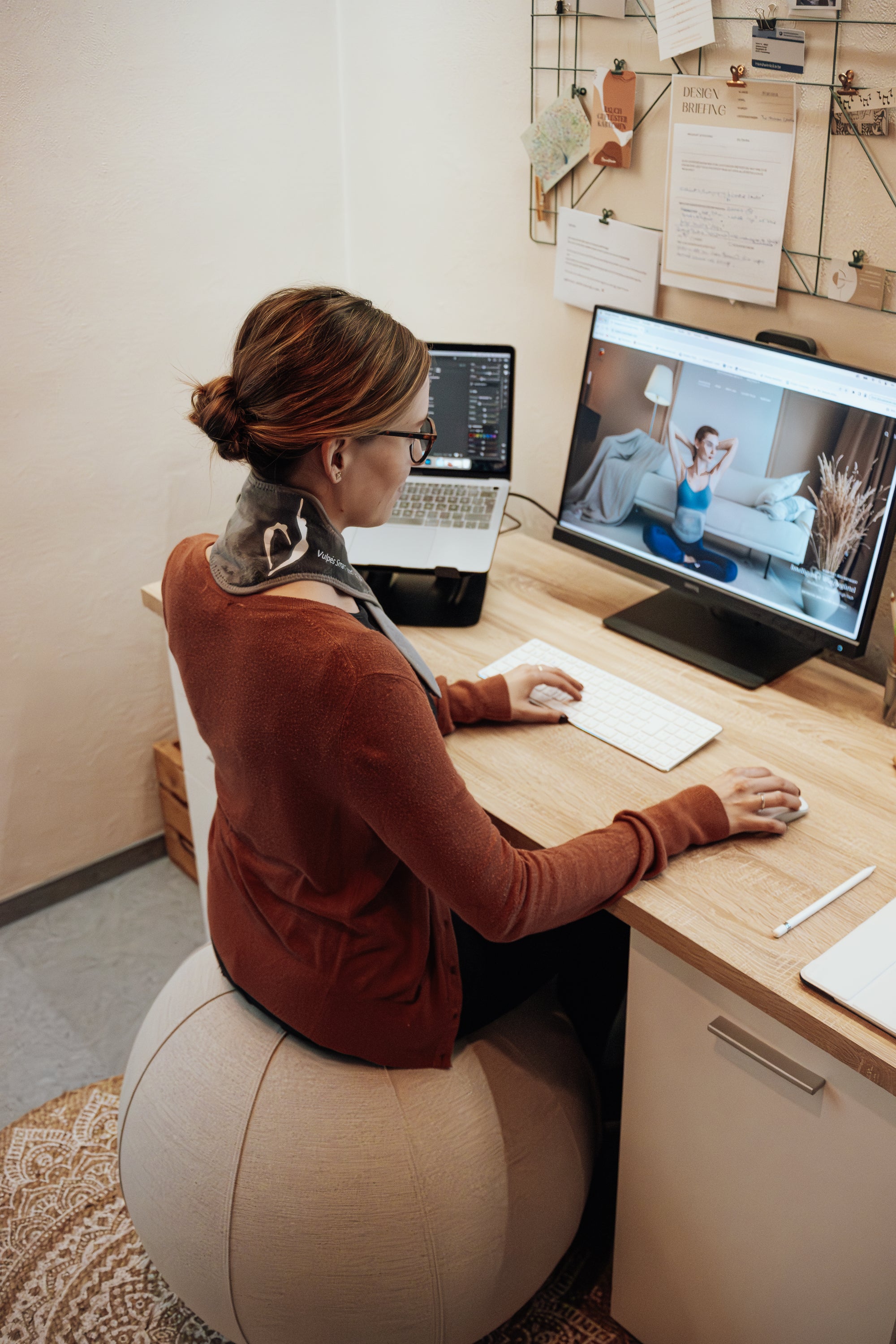Muscle tension, particularly in the neck, shoulders, and lower back, is a common problem for people who spend extended hours working in an office setting. The sedentary nature of most office jobs, combined with poor ergonomics and stress, can lead to discomfort that negatively impacts both physical health and productivity. One increasingly popular solution to alleviate this discomfort is heat therapy. This article will explore how heat therapy can effectively reduce office-related tension, its scientific basis, and how it can be applied in daily office life.
1. Understanding Office-Related Muscle Tension
To fully appreciate the benefits of heat therapy, it is essential to first understand the causes of muscle tension in an office environment.
1.1. Prolonged Sitting and Poor Posture
Most office work involves sitting for extended periods, often in front of a computer. Sitting for long hours puts pressure on the spine and can lead to muscular imbalances, particularly if posture is not optimized. A slouched or forward-leaning posture often results in tightness and discomfort in the neck, shoulders, and lower back. Over time, this can lead to chronic pain if not properly addressed.
1.2. Lack of Movement
Office jobs tend to limit physical movement, and prolonged immobility can result in muscle stiffness and decreased circulation. Regular movement is crucial for maintaining muscle flexibility and ensuring that blood flow delivers oxygen and nutrients to tissues. Without enough movement, the muscles become tense, making discomfort more likely.
1.3. Stress and Mental Strain
Psychological stress, which is common in fast-paced office environments, also contributes to muscle tension. The body responds to stress by activating the sympathetic nervous system, which increases muscle tension, particularly in the upper body. Chronic stress can exacerbate physical symptoms, leading to lasting discomfort and reduced well-being.
2. What Is Heat Therapy?
Heat therapy, or thermotherapy, is the practice of applying heat to specific parts of the body to alleviate pain and relax muscles. The application of heat can take many forms, including heating pads, warm compresses, and infrared therapy devices. Heat therapy works by increasing blood flow to the affected area, which helps to relax tight muscles, reduce stiffness, and alleviate discomfort.
2.1. Physiological Effects of Heat
When heat is applied to the skin, it causes blood vessels to dilate, which improves circulation. This enhanced blood flow helps to deliver oxygen and nutrients to the muscles and remove waste products such as lactic acid, which can build up during muscle tension. Additionally, heat increases the elasticity of tissues, making them more flexible and less prone to injury. These effects combine to promote relaxation and relief from tension.
2.2. Types of Heat Therapy
There are several types of heat therapy that can be used for tension relief, each with its own advantages:
- Dry Heat: Examples include electric heating pads and heat lamps. Dry heat provides consistent warmth and can be easily applied to different areas of the body.
- Moist Heat: Moist heat sources, such as warm towels or steam heating pads, tend to penetrate deeper into muscles and can be more effective for severe muscle tension.
- Infrared Heat: Infrared heat therapy uses electromagnetic radiation to heat tissues directly, without heating the surrounding air. This method can penetrate deeper into the body and is often used in specialized heat therapy devices.
3. Benefits of Heat Therapy for Office Workers
Heat therapy offers several significant benefits for individuals suffering from muscle tension related to office work. Understanding these benefits can help office workers incorporate heat therapy into their daily routines to improve their comfort and productivity.
3.1. Relief of Muscle Tension
The primary benefit of heat therapy is its ability to relax tense muscles. For office workers who experience tightness in their necks, shoulders, and lower backs due to prolonged sitting or poor posture, applying heat can significantly reduce discomfort. Regular use of heat therapy can also prevent muscles from becoming overly tight in the first place.
3.2. Improved Flexibility and Range of Motion
Muscle stiffness, especially in the back and shoulders, often limits movement and can make simple tasks feel difficult or uncomfortable. By increasing the elasticity of muscles and connective tissues, heat therapy can enhance flexibility and improve range of motion. This is particularly beneficial for office workers who may need to stretch or adjust their posture throughout the day.
3.3. Enhanced Circulation
One of the key physiological effects of heat therapy is improved blood flow to the targeted area. Enhanced circulation helps speed up the healing process for muscle strains and reduces inflammation. In office environments, where sitting for long periods can decrease circulation, using heat therapy can help counteract these effects and maintain healthy muscle function.
3.4. Reduction of Stress and Anxiety
Heat therapy not only addresses physical discomfort but can also help reduce stress and promote relaxation. Warmth has a calming effect on the nervous system, which can help reduce the physical manifestations of stress, such as tight muscles and tension headaches. By incorporating heat therapy into the workday, employees may find themselves feeling more relaxed and less prone to stress-related discomfort.
4. Practical Applications of Heat Therapy in the Office
Implementing heat therapy into a typical office routine is easier than it may seem. Here are several practical ways to apply heat therapy throughout the workday to combat tension and discomfort.
4.1. Portable Heating Pads
Portable heating pads are one of the most convenient tools for applying heat therapy in the office. These devices can be used while sitting at a desk and provide targeted relief for areas such as the lower back or shoulders. Many modern heating pads are battery-operated, making them easy to transport and use discreetly during the workday.
4.2. Heated Office Chairs or Cushions
Heated cushions or office chairs with built-in heating elements offer another practical way to incorporate heat therapy into an office setting. These products provide continuous, gentle warmth to the lower back and help reduce stiffness caused by prolonged sitting. Heated chairs can also help maintain good posture by encouraging relaxation of the muscles surrounding the spine.
4.3. Warm Compresses or Heat Wraps
For those who experience tension in the neck and shoulders, warm compresses or heat wraps can be a simple yet effective solution. These wraps can be heated in a microwave and applied directly to the affected areas. They are portable and can be used during breaks or even while working at a desk, helping to alleviate muscle tension in key areas.
4.4. Heated Belts
Heated belt devices are particularly effective for office workers who experience lower back tension and discomfort due to prolonged sitting. These belts are designed to wrap around the lower back or lumbar region, providing targeted heat directly to the muscles that are most prone to stiffness and pain in an office setting.
Heated belts are often adjustable, allowing users to customize the level of heat intensity. Many models are wireless and powered by rechargeable batteries, making them highly portable and easy to wear under clothing without restricting movement. The lightweight design means that these belts can be worn comfortably throughout the workday, providing continuous heat to relieve tension without interrupting productivity.
The consistent application of heat from a heated belt promotes better circulation in the lower back, helping to relax muscles and improve posture. For individuals dealing with chronic back pain or tension, using a heated belt for 20-30 minutes during breaks or while sitting at a desk can make a noticeable difference in comfort and mobility. Some belts also feature vibration or massage functions, offering additional therapeutic benefits.
4.5. Infrared Heat Therapy Devices
Infrared heat therapy devices are becoming increasingly popular due to their ability to penetrate deeper into muscles. These devices are typically small and portable, making them suitable for office use. Infrared heat can be applied to various muscle groups and offers long-lasting relief from tension and discomfort.
5. Combining Heat Therapy with Other Tension-Relief Strategies
While heat therapy is an effective standalone treatment for muscle tension, it works best when combined with other tension-relief strategies. Office workers can create a more comprehensive approach to preventing and alleviating discomfort by incorporating the following practices alongside heat therapy.
5.1. Stretching and Mobility Exercises
Stretching throughout the day can help counteract the negative effects of prolonged sitting and improve muscle flexibility. Simple neck, shoulder, and back stretches can be done at a desk, and when combined with heat therapy, they can provide lasting relief from tension.
5.2. Proper Ergonomics
Ensuring that the workstation is ergonomically optimized is crucial for preventing tension. This includes adjusting the height of the chair, positioning the computer monitor at eye level, and using an ergonomic keyboard and mouse. Heat therapy can then be used to address any residual discomfort caused by minor posture issues.
5.3. Regular Movement Breaks
Taking regular breaks to stand, walk, and stretch is essential for reducing muscle tension. These breaks help improve circulation and relieve the stiffness that comes from sitting in one position for too long. Incorporating movement into the day, even for a few minutes, can enhance the effects of heat therapy.
6. Safety Considerations for Heat Therapy
While heat therapy is generally safe, there are a few precautions to keep in mind to avoid injury.
- Temperature Control: Heating devices should not be too hot to avoid burns or skin irritation. Most modern heating pads come with temperature controls to ensure safe use.
- Duration: Heat should be applied in moderation. For most people, 15-20 minutes of heat therapy at a time is sufficient.
- Medical Conditions: Individuals with certain medical conditions, such as diabetes or cardiovascular issues, should consult a healthcare professional before using heat therapy, as they may be more sensitive to temperature changes.
Heat therapy offers a simple, effective, and accessible way to relieve muscle tension in the office. By promoting relaxation, improving circulation, and reducing stress, heat therapy can help prevent and alleviate the discomfort caused by long hours of sitting and poor posture. Incorporating heat therapy into an office routine, alongside proper ergonomics, regular movement, and other tension-relief strategies, can significantly improve well-being and productivity. As office work continues to be a central part of modern life, finding practical ways to address its physical challenges, such as muscle tension, is crucial for maintaining long-term health.



